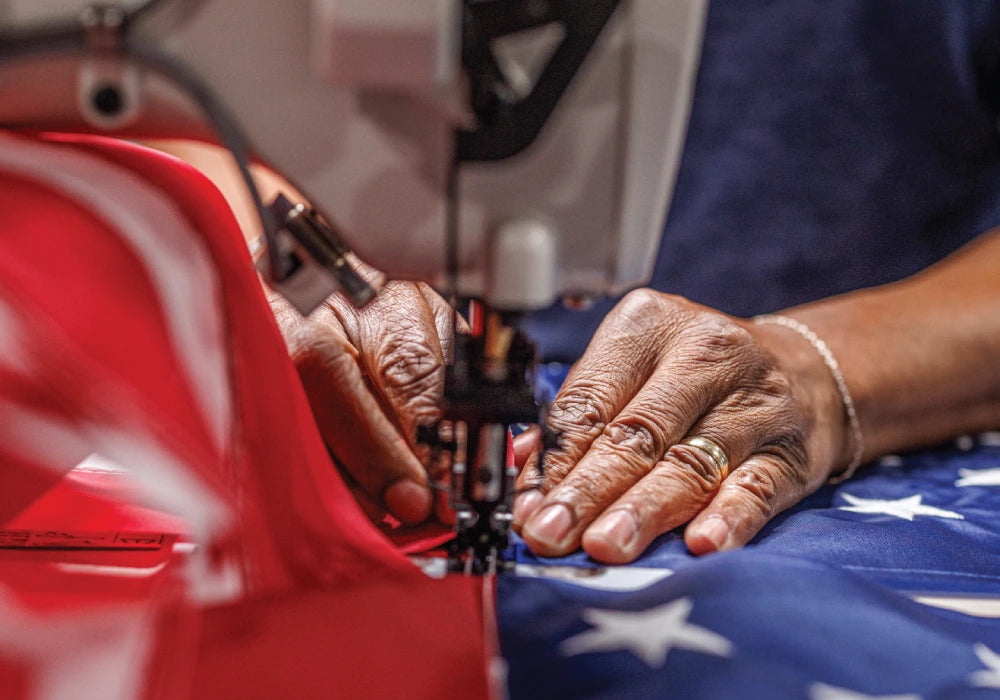The American flag is a symbol of the United States of America and represents the country's freedom and unity. It is also known as the Stars and Stripes, Old Glory, and the Star-Spangled Banner. The history of the American flag is a story of evolution and change. From the first flags of the American Revolution to the current flag, the Stars and Stripes has undergone many changes to become the iconic symbol it is today. In this article, we will take a comprehensive look at the history of the American flag, including the flags of the American Revolution, the Stars and Stripes, and the controversies surrounding the flag.
The Flags of the American Revolution
Notable historical flags that have been preserved, their stories, and their significance in American heritage.
The Grand Union Flag
This was the first flag used by the American colonies during the Revolutionary War. It featured 13 red and white stripes and the Union Jack in the corner, representing the colonies' loyalty to King George III.

The Betsy Ross Flag
The Betsy Ross Flag is an important symbol of the American Revolution. According to legend, George Washington, Robert Morris, and George Ross visited Betsy Ross in 1776 to commission her to make the first American flag. The flag featured 13 stars in a circle on a blue field, with 13 red and white stripes.
The Culpeper Minutemen Flag
This flag was used by a militia group in Culpeper, Virginia during the Revolutionary War. It featured a snake and the words "Don't Tread On Me" on a yellow field, symbolizing the colonies' determination to fight for their rights.
The Bennington Flag
The Bennington Flag was used by the Green Mountain Boys, a militia group from Vermont, during the Revolutionary War. It featured a green pine tree and the words "Freedom or Death" on a blue field.
Flags Related to or Influenced by the American Flag
The American flag’s iconic design has served as a model and source of inspiration for numerous flags both within the United States and across the globe. Domestically, many U.S. state and territory flags incorporate elements reminiscent of the national flag, such as stars, stripes, and the red, white, and blue color palette, to express unity and allegiance to the Union. For example, the flags of states like Hawaii and North Carolina prominently feature stars or stripes as a tribute to the nation’s emblem. Internationally, the influence of the American flag is particularly evident in the flags of countries that share historical or ideological connections with the United States. Liberia’s flag, for instance, was intentionally designed to resemble the Stars and Stripes, symbolizing the nation’s founding by formerly enslaved people from America and its close ties to American ideals. Other countries, such as Malaysia, Uruguay, and Cuba, have adopted flags that echo the U.S. flag’s use of stripes or a canton with stars, reflecting aspirations of independence, unity, or republican government. Even protest and regional flags, like the flag of Bikini Atoll, have drawn on American symbolism to convey specific historical messages. Through these adaptations, the American flag’s legacy endures as a global symbol of freedom, independence, and democratic values.
The Stars & Stripes
Progression of the flag’s design, including the addition of stars and stripes, and notable variants used throughout history.
Changes To The Flag Over Time
As the United States grew and new states joined the Union, the flag has undergone several changes. In 1795, two stars and two stripes were added to the flag to represent the addition of Vermont and Kentucky. In 1818, the number of stripes was fixed at 13 and stars were added to represent new states. Today the flag has 50 stars to represent the 50 states.
The Significance Of The Colors & Symbols
There are symbolic interpretations of the flag’s elements, such as colors, stars, and stripes. The colors of the American flag made in the USA have significant meaning. Red symbolizes valor and bravery, white symbolizes purity and innocence, and blue represents vigilance, perseverance, and justice. The stars symbolize the states and their unity, while the stripes represent the original 13 colonies.
Legislative Acts and Official Changes
Throughout its history, the American flag has been directly shaped by a series of legislative acts, congressional resolutions, executive orders, and judicial decisions that have defined its design, proportions, and even its legal status. The first and most foundational of these was the Flag Resolution passed by the Continental Congress on June 14, 1777, which declared: “Resolved, That the flag of the thirteen United States be thirteen stripes, alternate red and white; that the union be thirteen stars, white in a blue field, representing a new constellation.” While this act established the essential elements of the flag, it left many specifics, such as the arrangement of stars and the precise shade of colors, open to interpretation, resulting in a variety of early flag designs.
As new states joined the Union, Congress responded with further legislation to ensure the flag reflected the evolving nation. The second Flag Act, passed in 1794, increased the number of stars and stripes to fifteen, representing the addition of Vermont and Kentucky. However, as the country continued to expand, it became clear that adding a stripe for each state would quickly become impractical. To address this, Congress enacted the Flag Act of 1818, which fixed the number of stripes at thirteen to honor the original colonies and established that a new star would be added for each new state, effective on the Fourth of July following a state’s admission. This act set the precedent for the flag’s ongoing evolution, with each new state’s entry marked by the addition of a star.

Beyond congressional acts, executive orders have also played a crucial role in standardizing the flag’s design. In 1912, President William Howard Taft issued an executive order specifying the proportions of the flag and the arrangement and orientation of the stars for the first time, bringing uniformity to what had previously been a patchwork of designs. Later, President Dwight D. Eisenhower issued orders to update the star arrangement following the admission of Alaska and Hawaii, resulting in the current 50-star flag. In addition to design changes, laws have addressed the flag’s use and protection. The United States Flag Code, established in 1942 and later codified in Title 4 of the U.S. Code, provides guidelines for displaying and respecting the flag, though it does not prescribe penalties for violations. Over the years, both federal and state governments have enacted and revised flag desecration statutes, seeking to protect the flag from acts deemed disrespectful. However, landmark Supreme Court cases ruled that flag desecration is a form of symbolic speech protected by the First Amendment, limiting the government’s ability to enforce such laws. Through these legislative acts, resolutions, executive orders, and court decisions, the American flag has become not only a symbol of the nation’s ideals but also a living document of its legal and political history. Each change in its design and each debate over its use reflects the evolving story of the United States itself, ensuring that the flag remains both a constant and a dynamic emblem of American identity.
The American Flag In War & Peace
The War of 1812
The American flag played a significant role in the War of 1812. The flag was flown during the Battle of Baltimore, where it inspired Francis Scott Key to write the poem "The Star-Spangled Banner," which later became the national anthem.
The Civil War
The flag was a symbol of unity and freedom during the Civil War, with both the Union and Confederacy using versions of the flag. The Union flag was flown during battles such as Gettysburg and Vicksburg, while the Confederacy used their own version of the flag, which featured the stars arranged in a circle on a blue field.
World War I & World War II
The flag was flown during both World War I and World War II, symbolizing the country's commitment to freedom and democracy. The flag was displayed on ships, tanks, and airplanes, and was a source of inspiration for soldiers and civilians alike.
Modern Uses Of The Flag Today
The American flag is still an important symbol of the United States. It is displayed on government buildings, schools, and homes across the country. It is also used in patriotic celebrations such as Independence Day and Memorial Day.
Display, Etiquette, and Usage
Properly displaying, handling, and respecting the flag is a matter of national tradition and pride, governed by well-established customs and guidelines. Understanding these rules ensures that the flag is always treated with the dignity it deserves, whether at home, in public, or during special ceremonies.
-
Raising and Lowering the Flag: The American flag should be raised briskly at sunrise and lowered ceremoniously at sunset. If displayed at night, it must be properly illuminated. When the flag is being raised or lowered, everyone present should face the flag and stand at attention, with civilians placing their right hand over their heart. Uniformed military personnel should render the appropriate salute. The flag should never be allowed to touch the ground during these procedures.
-
Displaying the Flag Indoors and Outdoors: When displayed against a wall, the union (blue field of stars) should always be at the top and to the flag’s own right (observer’s left). If hung vertically in a window or on a wall, the union must be uppermost and to the observer’s left. Outdoors, the flag should be flown on its own right, higher than any other flag when displayed with others, and should never be draped over vehicles, objects, or used as clothing or bedding.
-
Half-Staff Protocol: The flag is flown at half-staff as a mark of respect or mourning, such as on Memorial Day (until noon), or by presidential or gubernatorial proclamation. To display the flag at half-staff, it should first be hoisted to the peak for an instant, then lowered to the half-staff position. Before being lowered for the day, it should again be raised to the peak and then lowered ceremoniously.
-
Respectful Handling and Disposal: The flag should never touch anything beneath it, including the ground, floor, water, or merchandise. When a flag becomes worn or faded, it should be retired in a dignified manner, preferably by burning in a respectful ceremony. Many organizations, such as the American Legion or Boy Scouts, offer flag retirement services to ensure proper disposal.
-
Display During Ceremonies and Parades: During parades or ceremonial occasions, the flag should always be carried aloft and free, never flat or draped. When passing in a procession, all present should face the flag and render the proper salute. The flag should never be dipped to any person or thing, except as a naval tradition when saluting ships of foreign nations.
-
Special Days and Locations for Display: The flag should be displayed on all national and state holidays, and on special occasions proclaimed by the President. It is also customarily flown at government buildings, schools, and polling places. Certain locations, such as the White House, Fort McHenry, and the U.S. Marine Corps Memorial, are authorized to fly the flag 24 hours a day by law or presidential proclamation.
By following these customs and rules, Americans honor the flag and the ideals it represents. Observing proper etiquette not only demonstrates respect for national traditions but also reinforces the shared values and unity that the flag embodies. Whether at home, in public, or during solemn occasions, treating the flag with reverence is a meaningful expression of patriotism.

The American flag is a symbol of freedom and unity that has undergone many changes throughout its history. From the flags of the American Revolution to the current Stars and Stripes, the flag has played an important role in the country's history. The American flag remains an important symbol of the United States, and continues to be displayed and respected by citizens across the country. As we look back on the history of the American flag, it's important to remember that it's not only a symbol of our past but also a symbol of our present and future. It's a reminder of the sacrifices made by those who came before us, and a symbol of the freedom and unity we continue to strive for. Looking to buy an American flag? Discover Allegiance Flag Supply, the best American flag store.






